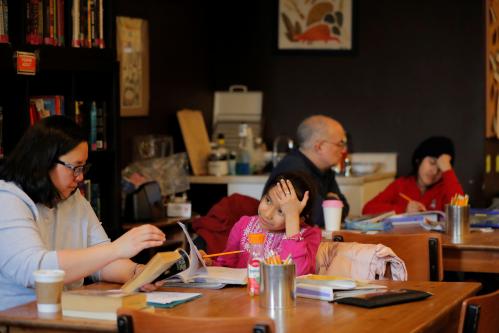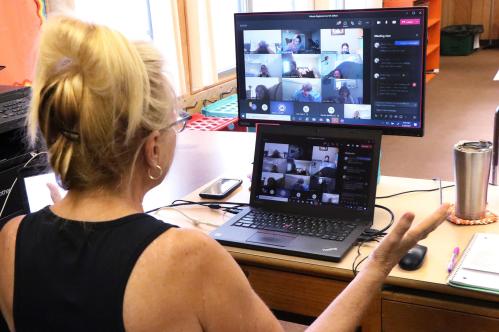With a month or so until back-to-school season, with districts’ plans up in the air—and with President Trump and Secretary of Education Betsy DeVos demanding schools be back in session in the fall—the stress on our education system is at a record high. Researchers are also furiously at work trying to understand the impacts of COVID-19 and school closures on student and parent experiences. For instance, the REACH Center has recently gathered information on school districts’ reopening plans using district websites, and the Understanding America Study (UAS) has been following a nationally representative panel of families to understand how coronavirus is affecting K-12 and higher education experiences and plans.
Regardless of whether schools open in-person, online, or some combination, communication between districts and families will be essential. Families need information about educational plans, about COVID-related illnesses in the community, and about how to support their children’s learning. They need that information quickly, and they need it in clear and accessible formats. Prior work has found parents are mostly satisfied with the communication they have received. For instance, the UAS found that 77% of parents feel “satisfied with the communication to support learning from their children’s school(s).” While these data are useful, I wanted to get a more fine-grained sense of the communication parents are receiving during COVID-19, how helpful it is, and how parents from different groups differ in their opinions about communication.
Survey results from New Mexico
The data for the analysis come from a statewide survey conducted by the state of New Mexico in cooperation with Tripod Education. The survey was made available to all districts in the state to share with their parents. The sample is not intended to be representative, but it is large and diverse. Over 21,000 parents completed the survey (the state has about 340,000 schoolchildren, so this represents somewhere between 6 and 10% of parents in the state). The responding parents are quite diverse: 45% of their children receive free or reduced-price lunch; 41% are white, 29% are Hispanic, 4% are American Indian, and 25% are multiracial or of other races; and 24% receive special-education services.
Parents were asked a series of questions about their children’s education since COVID-related shutdowns. They were asked about their children’s experiences before COVID-19, and then they were asked about their experiences since COVID-related shutdowns. The items and the mean and distribution of ratings are shown in Figure 1 below. (There were nine other items asked as well; only the communication-related items are included here). Based on these results, several patterns emerge.
First, parents may be more dissatisfied about school communication than has been widely reported. Although differences in item wording may account for the different results across surveys, the dissatisfaction that parents expressed about school communication in this survey is striking. The two lowest-rated items are communication related: “My child’s school provides guidance and resources in a language that is accessible to me and my family” (27% agree or strongly agree), and “I am satisfied with the information on how to help my child with learning at home” (4% agree or strongly agree). Prior to COVID-19, parents were much more positive about communication, with 89% agreeing or strongly agreeing about the accessibility of guidance and 59% agreeing or strongly agreeing about information to help their child at home.
Second, parent dissatisfaction might be about the quantity of communication, but it might be about other things as well. In fact, there is some ambivalence about quantity. Forty-one percent of parents agree or strongly agree that “I would like my child’s school/teacher to communicate with me less often,” and 41% also agree or strongly agree that “I would like my child’s school/teacher to communicate with me more frequently” both close to “somewhat agree.”
Third, responses about communication differ across demographic and other groups. In terms of race/ethnicity, white parents are least likely to agree that “My child’s school provides guidance and resources in a language that is accessible to me and my family,” least satisfied with information about how to help learning at home, and least likely to want less frequent communication. There are large grade-span differences, with parents of middle and high school-age children far more likely to want more communication and less likely to want less communication. And there are large differences for families that speak English at home, with less agreement on all items than families that don’t speak English. (The survey was translated into both Spanish and Navajo.)
Fourth, there are important differences based on whether families have computers. Forty-one percent of families with a computer agree or strongly agree that they would like less communication, compared to 32% of families without a computer. Similarly, 50% of parents without a computer agree or strongly agree that they would like more communication, versus just 40% of families without a computer. From these results, we might infer that having a computer gives parents the access they need to district-provided communication, but also that this information might be a bit like drinking from a fire hose. Parents may want a bit less, but more targeted information.
Of course, there are many more interesting and important results to take away from this survey, but I take away a few key findings and suggestions. For one, I take these results to imply that communication may be an area of performance where parent support for schools is especially soft, and it is also an area that is largely under schools’ control. While there are some parents who think there is too much communication, I think district leaders should err on the side of more communication than less. Though there is the possibility that communicated plans may change, I think district leaders can acknowledge that uncertainty in their communication. Another takeaway is that there are important and large gaps in parents’ communication experiences under the pandemic, and not always in the direction we might expect—schools may have to work especially hard to communicate with families that lack technology and with families of older students. And last, these results differ somewhat from what others have reported and may point to the importance of time and setting in affecting parents’ attitudes and experiences related to COVID-19 in schools.








Commentary
Parent dissatisfaction shows need to improve school communication during coronavirus pandemic
July 23, 2020